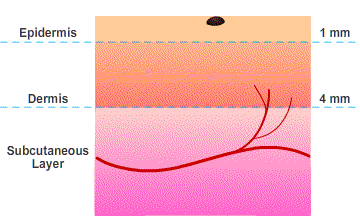 |
In most cases, melanoma is easy to self-detect at an early stage while it is curable by simple surgical excision. Although the visual appearance of a skin lesion (a growth or mark) is often an indication of melanoma, you cannot always rely on this alone. You should also be aware of the history of your skin lesions—any changes that occur in them, as well the onset of any new ones. The only way to develop this awareness is by regular self-examination of your skin. We recommend a complete self-skin exam once every month.
|
| |
  Any change Any change in a mole, blemish, freckle, birthmark, or pigmented area |
| |
  |
A new mole or freckle that appears out of the blue or is growing rapidly, especially if you don't have many moles, or the new mole or freckle looks different from those you do have |
| |
|
| |
|
| |
  A change in surface texture or in the way a mole feels to the touch |
| |
  A new "freckle" that is dark, dry, or scaly |
| |
  A pigmented area or splotch that is new or that you don't remember seeing before |
| |
  A new spot that is black, even if very small |
| |
  |
A mole or other spot that looks or behaves differently than those around it, even if it seems otherwise normal |
| |
|
| |
  A mole or other spot that itches and/or bleeds |
| |
  Redness, other color, or shadow extending into the surrounding skin |
There are two types of melanoma: radial and nodular. Radial melanomas are easier to self-detect because they grow in diameter near the skin surface before growing downward through the skin. Radial melanomas usually have two or more of the ABCD properties, as shown below.
Please note these photos show only a few of many different ways melanomas may appear; read this entire page to learn about other possible warning signs.
In the animation above, the earliest signs of an atypical mole changing into a radial melanoma are 1) the increase in size, and 2) the shape becoming more irregular. This is the time to act. As the melanoma continues to grow, its color becomes darker and less uniform, black bumps begin to appear, and in the late stages, most of the melanoma has become black and lumpy. The initial appearance of bumps often signals the last chance to act before a melanoma spreads internally.
This represents just one of many different ways a mole can change. Usually these changes occur over a period of several weeks, or more typically, months. Although not all changes will turn out to be melanoma, don't take any chances, and above all, don't make the mistake of trying to be your own doctor.
In addition to the ABCD properties, there is an E change to watch for, and if you see it you should act immediately. E equals elevation. The beginning of a bump or thickness increase in a mole, freckle, blemish, or birthmark—even if the increase is small—often signifies a melanoma that is entering a dangerous phase. Elevation changes are critical because, when the thickness of a melanoma exceeds 1 mm, the chance of internal spread increases. When the thickness reaches 3 mm, curability is only about 50 percent and quickly decreases as the thickness increases further.

The animation above shows a radial melanoma growing into the skin. Radial melanomas start in the thin outer layer of the skin (the epidermis) and at first usually undergo a surface growth phase that is noninvasive and completely curable. As the melanoma grows and reaches the middle layer of the skin (the dermis), it begins an "invasive radial" growth phase. Still, curability is about 90 percent at this point. As it penetrates further into the dermis, however, it begins an "invasive vertical" growth phase, becoming less curable as downward growth progresses into the loose connective tissue beneath the dermis (the subcutaneous layer). Malignant cells may be released into lymph and blood vessels, spreading to other parts of the body.
In short, a lump or elevation increase above the surface of the skin is a warning sign of vertical growth beneath the surface.
About 20 percent of melanomas begin the dangerous vertical growth phase with little or no radial growth first. For these nodular melanomas the ABCD properties do not apply; instead they have three combined EFG properties.
Any of the following warning signs may indicate a nodular melanoma:
-
In otherwise clear skin, the beginning of a bump that looks like a blood blister, bubble, or pimple that continues to grow after two to three weeks, especially if you don't ordinarily have pimples and haven't injured yourself at the site of the blood blister.
Although a nodular melanoma can arise in a pre-existing mole, it is more common for one to develop spontaneously from normal skin, as in the four photos above. All of these were fatal. The colors of nodular melanomas are usually black, blue-black, dark brown, or brown-red. However, occasionally they are red (third photo from left), pink, grey, flesh-tone, or light to medium brown (far right photo, from the ankle of a 12-year-old boy). Nodular melanomas are typically dome-shaped and lacking in the ABCD properties, making visual diagnosis more difficult than with radial melanomas.
|
 |